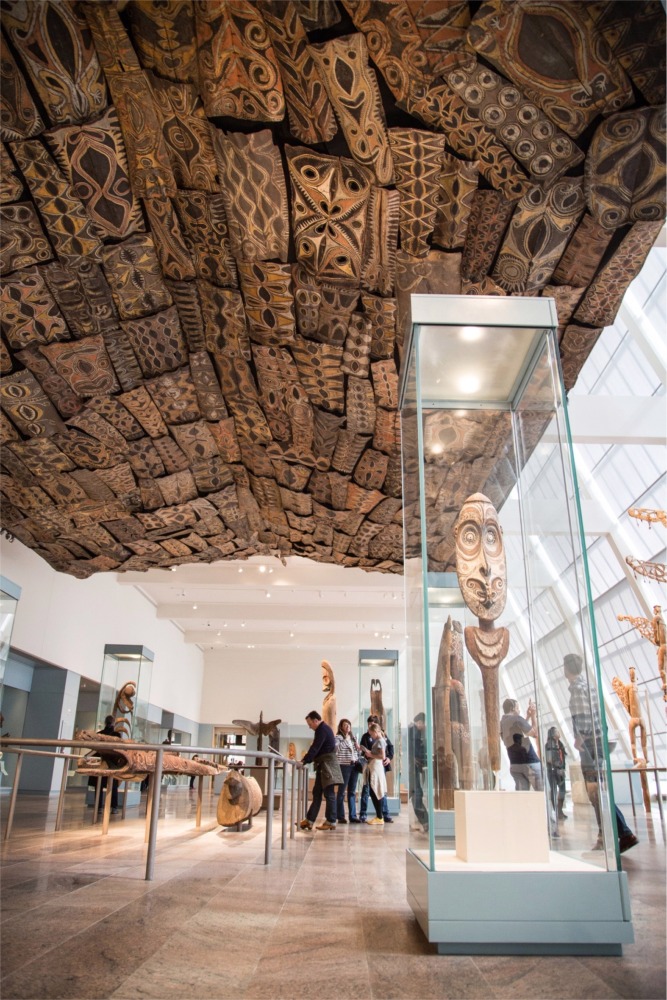Oceanic Art
Home > New York State Photographs > Metropolitan Museum of Art > Oceanic Art

This photograph shows The Michael C. Rockefeller Wing at the Metropolitan Museum of Art in New York City. This wing contains Oceanic Art at the MET.
Arts of Africa, Oceania, and the Americas
Though the Met first acquired a group of Peruvian antiquities in 1882, the museum did not begin a concerted effort to collect works from Africa, Oceania, and the Americas until 1969, when American businessman and philanthropist Nelson A. Rockefeller donated his more than 3,000-piece collection to the museum. Before Rockefeller's collection existed at the Met, Rockefeller founded The Museum of Primitive Art in New York City with the intention of displaying these works, after the Met had previously shown disinterest in his art collection. In 1968, the Met agreed to a temporary exhibition of Rockefeller's work. However, the Met then requested to include the arts of Africa, Oceania, and the Americas in their personal collection and on permanent display. The arts of Africa, Oceania, and the Americas opened to the public in 1982, under the title, "The Michael C. Rockefeller Wing." This wing is named after Nelson Rockefeller's son, Michael Rockefeller, who died while collecting works in New Guinea.
Today, the Met's collection contains more than 11,000 pieces from sub-Saharan Africa, the Pacific Islands, and the Americas and is housed in the 40,000-square-foot (4,000 m2) Rockefeller Wing on the south end of the museum. The Wing exhibits Non-Western works of art created from 3,000 BCE – the present, while at the same time displaying a wide range of cultural histories. This is considered to be the first time arts outside of the West were placed alongside Western art in a Western museum. Before then, the works of art from Africa, Oceania, and the Americas were considered the art of the "primitives" or ethnographic objects.
The Wing exhibits the arts of Africa, Oceania, and the Americas in an exhibition separated by geographical location. The collection ranges from 40,000-year-old indigenous Australian rock paintings to a group of 15-foot-tall (4.6 m) memorial poles carved by the Asmat people of New Guinea, to a priceless collection of ceremonial and personal objects from the Nigerian Court of Benin donated by Klaus Perls. The range of materials represented in the Africa, Oceania, and Americas collections is undoubtedly the widest of any department at the Met, including everything from precious metals to porcupine quills. The Michael C. Rockefeller Wing's exhibition space is planned to be renovated between 2020 and 2023.
Curator of African Art Susan Mullin Vogel reported on a famous Benin artifact gained by the Metropolitan Museum of Art in the year 1972. The item was originally auctioned in April 1900 by a lieutenant named Augustus Pitt Rivers at the price of 37 Guineas.
In December 2021, the Met began its $70 million renovation of the African, ancient American, and Oceanic art galleries, which is set for completion in 2024. Part of this 40,000-square-foot renovation will include the installation of a glass wall to better illuminate the galleries as well as featuring 3,000 new works.
The Metropolitan Museum of Art of New York
The Metropolitan Museum of Art in New York City, colloquially "the Met", is the largest art museum in the Americas. Its permanent collection contains over two million works, divided among 17 curatorial departments. The main building at 1000 Fifth Avenue, along the Museum Mile on the eastern edge of Central Park on Manhattan's Upper East Side, is by area one of the world's largest art museums. A much smaller second location, The Cloisters at Fort Tryon Park in Upper Manhattan, contains an extensive collection of art, architecture, and artifacts from medieval Europe.
The Metropolitan Museum of Art was founded in 1870 with its mission to bring art and art education to the American people. The museum's permanent collection consists of works of art from classical antiquity and ancient Egypt, paintings, and sculptures from nearly all the European masters, and an extensive collection of American and modern art. The Met maintains extensive holdings of African, Asian, Oceanian, Byzantine, and Islamic art. The museum is home to encyclopedic collections of musical instruments, costumes, and accessories, as well as antique weapons and armor from around the world. Several notable interiors, ranging from 1st-century Rome through modern American design, are installed in its galleries.
The Fifth Avenue building opened on March 30, 1880. In 2021, despite the COVID-19 pandemic in New York City, the museum attracted 1,958,000 visitors, ranking fourth on the list of most-visited art museums in the world.
From Wikipedia, the free encyclopedia.


